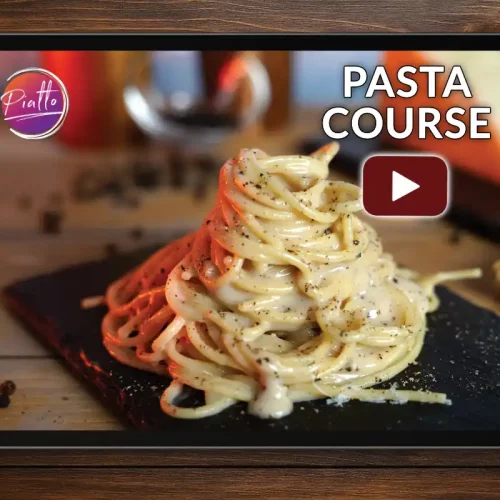Cacio e Pepe Pasta Course
One of the most distinctive recipes that you will find in any Rome restaurant. The traditional Cacio e Pepe has just three ingredients: pecorino cheese and black pepper ("cacio" and “pepe") and pasta. The trick to achieving its unmatched flavor? Quality ingredients and few simple cooking tricks.
Equipment
- Large Stock Pot to cook the pasta
- Large Skillet
Ingredients
- 11 oz spaghetti dry is fine; choose 'bronze die cut' whenever possible
- 1 tbsp black pepper freshly ground at a medium coarse setting or using a mortar and pestle
- 7 oz pecorino romano cheese finely grated; use semi-aged cheese
- 6 ¾ cups water for cooking the pasta
- coarse salt to taste
Instructions
Prepare Ingredients
- Freshly grate the pecorino with the finest setting available. You may use a food processor to do this quickly. Set aside.7 oz pecorino romano cheese
- Freshly grind the black pepper (1 ½ Tbs) using a medium-coarse setting. You can use a mortar and pestle if you prefer.1 tbsp black pepper
Toast the Black Pepper
- Toast pepper in a large skillet over very low heat just until fragrant. Then, remove pan from the heat. We recommend adding the pepper to a cold skillet, then turning the heat on low. Do not over toast! We don’t want to create pepper gas :)
Cook the Pasta
- In a medium-large pot, bring 6 ¾ cups of water to boil. Start cooking the pasta in this pot of water for just half of the cook-time indicated on the package for ‘al dente’ pasta—about 5 minutes.6 ¾ cups water, coarse salt, 11 oz spaghetti
Simmer the Pepper
- While pasta is cooking, add 2-3 ladles of the pasta water to the pan with the black pepper. Return the pan to the heat, and simmer the black pepper in the water for 2 minutes.
Finish the Pasta
- When the pasta is halfway through the cook time, transfer the pasta to the pan with the pepper-infused water.
- Add another ladle of hot pasta water to the pan—just enough to keep the pasta cooking. Finish cooking the pasta until it is al dente. In the meantime…
Make the Pecorino Sauce
- In a bowl, add ½ cup (100 ml) of the hot pasta water to a cup or bowl. Let the water cool a minute or two, or until it has reached a temperature of about 140° F (60° C). Don't have a thermometer? See Notes...
- Add this pasta water to the pecorino cheese.
- Mix thoroughly until you’ve achieved a smooth, thick paste— similar in appearance to a smooth ricotta cheese.
Add the Cheese Sauce
- Remove the skillet with the cooked pasta from the heat. Drain any excess water so only a tablespoon or two of liquid remains in the pan. Add the pecorino paste to the pasta.
- Stir quickly with a pair of tongs until the paste is distributed throughout the pasta and has created a thick, creamy sauce (much like a bechamel). If the pasta seems a bit too watery, remember it will become denser after plating. Serve immediately and Buon appetito!
Video
Nutrition
Sodium: 620mgCalcium: 563mgVitamin A: 214IUSugar: 2gFiber: 3gPotassium: 236mgCholesterol: 52mgCalories: 485kcalSaturated Fat: 9gFat: 15gProtein: 26gCarbohydrates: 61gIron: 2mg
Tried this recipe?Let us know how it was!
